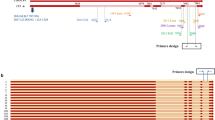Abstract
The emergence of the hypervirulent strain Clostridium difficile PCR ribotype 027 has increased the necessity for rapid C. difficile typing tests for clinical and epidemiological purposes. We developed a rapid real-time polymerase chain reaction (PCR) test for the detection of C. difficile. As the target, we chose the tcdC gene, which encodes for a negative regulator in toxin production. A deletion at position 117 of the tcdC gene, which is associated with severe tcdC truncation, is well conserved in all PCR ribotype 027 isolates. Probe sequences of the real-time PCR test were designed to result in distinct melt profiles for sequence variations at positions 117 to 120 of the tcdC gene. The tcdC gene deletion at position 117 was easily detected with real-time PCR and melt curve analysis in all C. difficile ribotype 027 isolates. In five non-027 strains and 46 hospitalised patient samples, melt curve analysis detected no deletion. PCR results were confirmed by DNA sequencing. The combination of real-time PCR and melt curve analysis is a rapid and accurate method for the detection of C. difficile DNA and simultaneous screening for the tcdC gene deletion at position 117, which is closely related to the C. difficile PCR ribotype 027 strain.

Similar content being viewed by others
References
Lyerly DM, Krivan HC, Wilkins TD (1988) Clostridium difficile: its disease and toxins. Clin Microbiol Rev 1:1–18
Hammond GA, Johnson JL (1995) The toxigenic element of Clostridium difficile strain VPI 10463. Microb Pathog 19:203–213. doi:10.1016/S0882-4010(95)90263-5
Krausz S, Bessems M, Boermeester MA, Kuijper EJ, Visser CE, Speelman P (2005) Life-threatening infections with a new strain of Clostridium difficile. Ned Tijdschr Geneeskd 149:2081–2086. In Dutch
Loo VG, Poirier L, Miller MA, Oughton M, Libman MD, Michaud S et al (2005) A predominantly clonal multi-institutional outbreak of Clostridium difficile-associated diarrhea with high morbidity and mortality. N Engl J Med 353:2442–2449. doi:10.1056/NEJMoa051639
Kuijper EJ, Coignard B, Tüll P; ESCMID Study Group for Clostridium difficile; EU Member States; European Centre for Disease Prevention and Control (2006) Emergence of Clostridium difficile-associated disease in North America and Europe. Clin Microbiol Infect 12:2–18. doi:10.1111/j.1469-0691.2006.01580.x
Kleinkauf N, Weiss B, Jansen A, Eckmanns T, Bornhofen B, Küehnen E et al (2007) Confirmed cases and report of clusters of severe infections due to Clostridium difficile PCR ribotype 027 in Germany. Euro Surveill 12:E071115.2
Kuijper EJ, Coignard B, Brazier JS, Suetens C, Drudy D, Wiuff C et al (2007) Update of Clostridium difficile-associated disease due to PCR ribotype 027 in Europe. Euro Surveill 12:E1–E2
Killgore G, Thompson A, Johnson S, Brazier J, Kuijper E, Pepin J et al (2008) Comparison of seven techniques for typing international epidemic strains of Clostridium difficile: restriction endonuclease analysis, pulsed-field gel electrophoresis, PCR-ribotyping, multilocus sequence typing, multilocus variable-number tandem-repeat analysis, amplified fragment length polymorphism, and surface layer protein A gene sequence typing. J Clin Microbiol 46:431–437. doi:10.1128/JCM.01484-07
Warny M, Pepin J, Fang A, Killgore G, Thompson A, Brazier J et al (2005) Toxin production by an emerging strain of Clostridium difficile associated with outbreaks of severe disease in North America and Europe. Lancet 366:1079–1084. doi:10.1016/S0140-6736(05)67420-X
Spigaglia P, Mastrantonio P (2002) Molecular analysis of the pathogenicity locus and polymorphism in the putative negative regulator of toxin production (TcdC) among Clostridium difficile clinical isolates. J Clin Microbiol 40:3470–3475. doi:10.1128/JCM.40.9.3470-3475.2002
MacCannell DR, Louie TJ, Gregson DB, Laverdiere M, Labbe AC, Laing F et al (2006) Molecular analysis of Clostridium difficile PCR ribotype 027 isolates from Eastern and Western Canada. J Clin Microbiol 44:2147–2152. doi:10.1128/JCM.02563-05
Curry SR, Marsh JW, Muto CA, O’Leary MM, Pasculle AW, Harrison LH (2007) tcdC genotypes associated with severe TcdC truncation in an epidemic clone and other strains of Clostridium difficile. J Clin Microbiol 45:215–221. doi:10.1128/JCM.01599-06
Sloan LM, Duresko BJ, Gustafson DR, Rosenblatt JE (2008) Comparison of real-time PCR for detection of the tcdC gene with four toxin immunoassays and culture in diagnosis of Clostridium difficile infection. J Clin Microbiol 46:1996–2001. doi:10.1128/JCM.00032-08
Bidet P, Barbut F, Lalande V, Burghoffer B, Petit JC (1999) Development of a new PCR-ribotyping method for Clostridium difficile based on ribosomal RNA gene sequencing. FEMS Microbiol Lett 175:261–266. doi:10.1111/j.1574-6968.1999.tb13629.x
Pituch H, Van Belkum A, Van Den Braak N, Obuch-Woszczatynski P, Verbrugh H, Meisel-Mikołajczyk F et al (2003) Recent emergence of an epidemic clindamycin-resistant clone of Clostridium difficile among Polish patients with C. difficile-associated diarrhea. J Clin Microbiol 41:4184–4187. doi:10.1128/JCM.41.9.4184-4187.2003
Pituch H, Kreft D, Obuch-Woszczatynski P, Wultańska D, Meisel-Mikołajczyk F, Łuczak M et al (2005) Clonal spread of a Clostridium difficile strain with a complete set of toxin A, toxin B, and binary toxin genes among Polish patients with Clostridium difficile-associated diarrhea. J Clin Microbiol 43:472–475. doi:10.1128/JCM.43.1.472-475.2005
Goorhuis A, Bakker D, Corver J, Debast SB, Harmanus C, Notermans DW, Bergwerff AA et al (2008) Emergence of Clostridium difficile infection due to a new hypervirulent strain, polymerase chain reaction ribotype 078. Clin Infect Dis 47:1162–1170. doi:10.1086/592257
Acknowledgements
We gratefully acknowledge TIB Molbiol (Berlin, Germany) for designing the primers and probes, Hans-Peter Weil for critical reading of the manuscript and Ute Neuelmann for the excellent technical assistance.
Author information
Authors and Affiliations
Corresponding author
Rights and permissions
About this article
Cite this article
Wolff, D., Brüning, T. & Gerritzen, A. Rapid detection of the Clostridium difficile ribotype 027 tcdC gene frame shift mutation at position 117 by real-time PCR and melt curve analysis. Eur J Clin Microbiol Infect Dis 28, 959–962 (2009). https://doi.org/10.1007/s10096-009-0731-7
Received:
Accepted:
Published:
Issue Date:
DOI: https://doi.org/10.1007/s10096-009-0731-7




